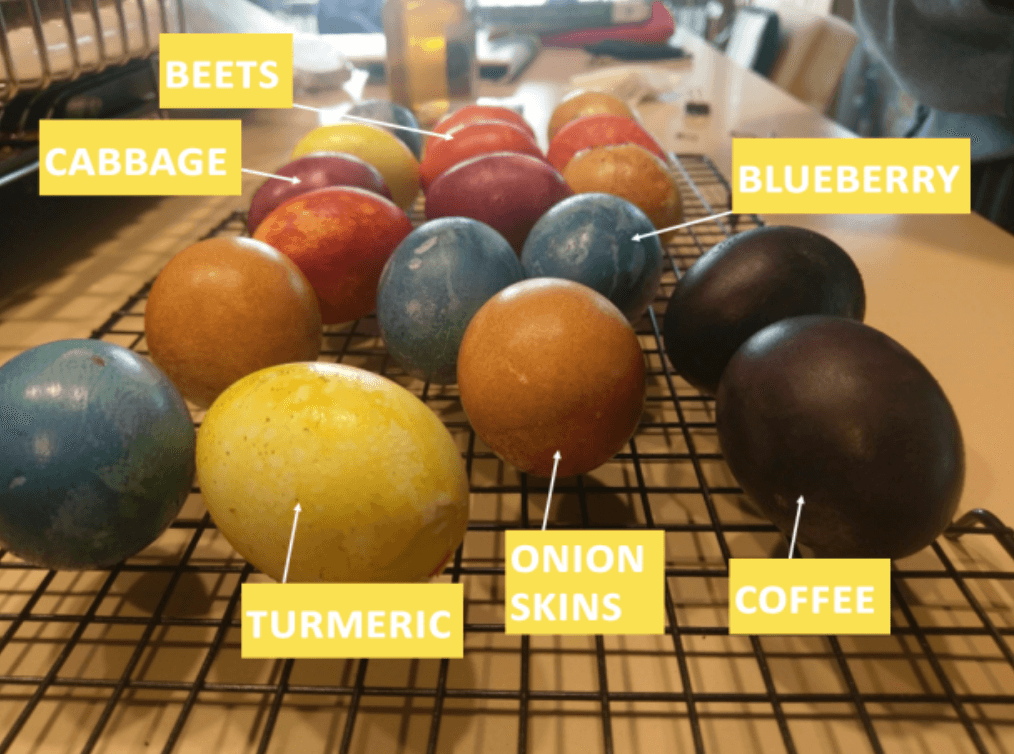How to Dye Easter Eggs with Foods from Your Own Home Kitchen
So it’s Easter season, and you’re at home, and you’re not ready with the traditional store-bought dye kit. Don’t worry! I got you! This year, break the habit of buying those kits, and try out this age-old method of household dye baths. These are all food based dyes, so there’s no chemicals to be found here.
I’ve tried different methods to this and what follows is a tried and true route for achieving the colors and consistency that you’re looking for. Don’t let something new stand in the way of savoring good traditions.
How to Dye Easter Eggs with Things in Your Kitchen
In this three-step process you’ll make all the dyes first, then boil and prepare the eggs, and finally dye the eggs. Equipment
- 1 pot per dye color
- mesh strainer
- cups or jars (to hold your dye baths and eggs in)
Ingredients
- Natural dye materials (shredded beets, turmeric, etc)
- Water
- 1 – 2 tbsp white vinegar (per dye color)
- eggs (however many you want to make) – white eggs work much better than brown at picking up the color of your dye baths · Coconut or olive oil (optional – for adding luster to eggs)
Instructions
Making Easter Egg Dye
- Go to the list below this recipe and determine what you have on hand that can serve for your dye baths. 2. Clean and prep your dye matter.
- Bring the dye matter and water to a boil in individual pots.
- Turn heat down to low and simmer, covered, for 15-60 minutes until desired color is reached. The eggs will be several shades lighter so it’s best to go for deep, rich hues.
- Remove the egg dye from heat and let it cool to room temperature.
- Pour the dye through a mesh strainer into the cups that you’ll be using for dyeing your eggs and add 1 tablespoon of vinegar for each cup of dye liquid.
Boiling the Eggs
- Add the eggs to a medium pot and cover them with cold water. Bring the water to a hard boil, then turn off the heat and cover the pot. After 10 minutes, place the eggs in a bowl of cold water and let them sit until they’re cool to the touch.
- Drain the bowl and replace with warm, soapy water – I use non-toxic castile soap. Gently rub the eggs with a washcloth or your thumb to remove oils that prohibit the natural dyes from adhering effectively to the egg shell.
**Want to get creative? Try adhering things to your eggs to help create stencils. Rubber bands or strings work great. Want multiple colors on one egg? Try placing them in different angles and levels in bowls to get variations of color and shape on the egg. What about designs? Try using wax crayons to make some drawings before you dye the egg. Really want to go all out? Go forage a leaf or fern and see if you can get that to act as your negative shape stencil.
Coloring The Eggs
- Lower the eggs into the dye and place them in the fridge. Soak until your desired color is reached. (We usually soak ours overnight.)
- When the eggs are ready scoop them out with a slotted spoon and place them on a drying rack or an upside down egg carton.
- Naturally-dyed eggs have a matte finish. If you’d like to add a little luster, rub with a drop or two of coconut or olive oil. Can the dyes be stored overnight and used the next day?
Yep!
Can I draw on the eggs with a wax crayon before dyeing them?
We haven’t tried this but I don’t see a reason not to as long as the crayons are non-toxic.
Do dyes change the flavor of the eggs?
Nope!
Dye sources, and the colors they produce
Following are the dye sources I’ve found to yield the richest colors. Remember to use
only edible plants or portions of plants (no rhubarb leaves, for example).
- Onion skins marbleized oranges and yellows
- Onion skins with unsprayed rose petals
peachy hues with green or yellow tints
- Shredded red cabbage midnight blue and teal • Beet root brown with a purple cast • Beet tops dove gray
- Spinach pale green
- Carrots yellow with olive overtones • Carrot tops soft gold
- Blue potatoes muted teal
- Grape juice deep lavender (for a lovely crystallized sugar coating, let the egg dry without rinsing)
- Blueberries (frozen is fine) deep blue
- Raspberries (frozen is fine) light fuchsia
- Blackberries (frozen is fine) plum
- Coffee milk-chocolate brown
- Black tea reddish tan
- Cinnamon subdued mahogany
- Paprika light orange
- Turmeric vivid gold
To Dye Easter Eggs Pink, You’ll Need:
- 2 cups water
- 2 cups peeled, grated beets
- 1-2 tablespoons white vinegar
To Dye Easter Eggs Orange, You’ll Need:
- 2 cups yellow onion skins
- Enough water to cover skins by 1 inch
- 1-2 tablespoons white vinegar
To Dye Easter Eggs Yellow, You’ll Need:
- 2 cups water
- 1 tablespoon turmeric
- 2 tablespoons vinegar creates
Other options: Strongly brewed chamomile tea creates a soft yellow. To Dye Easter Eggs Green or Blue, You’ll Need:
- 2 cups shredded purple cabbage
- Enough water to cover cabbage by 1 inch
- 1-2 tablespoons vinegar
Brown eggs will turn green and white eggs will turn blue.
Other options: Strongly brewed hibiscus tea (with one tablespoon vinegar per cup) will create the dark green pictured in the photo at the top. Blueberries will create a slightly marbled blue color.
Virtual Easter Egg Hunt
The Real Story of the Easter Bunny
Adapted from The Ostara Bunny by Rev. Christina Leone
Once upon a time, a long, long time ago… There was a Goddess. Her name was Ostara, or Eostre. Do you have any ideas what she might have been the Goddess of? What about words that are kind of similar to her name? (Easter)
She was the Goddess of springtime. What happens in springtime? (Flowers bloom, it gets warmer, new things are born, the world ‘wakes up’ from winter.)
This Goddess gave birth to the sun, and helped it shine brighter every day in the sky. She was the bringer of warmth, and color. Her festival day is the Spring Equinox (which happened this past Thursday,) and celebrates new life and springtime.
And one day, while she was going about her very important business, a little girl came to her. The little girl had found a small bird on the ground. The ground was still very cold, because spring was not quite there… Ostara hadn’t finished her work yet. The little bird was injured, and very cold… The little bird was dying.
“Please!” the little girl pleaded with the goddess Ostara. “Please save this little bird.” The goddess was annoyed. “Can’t you see that I’m busy here?” But the girl was persistent. “Please, it won’t take much. Just help bring the bird back to life!”
The Goddess was so moved by the little girl’s pleas that she agreed to help the bird However, the bird was too weak and broken to be fully fixed. The Goddess knew that something would have to change for the bird to survive. She carefully considered what to do and decided to turn the bird into a different animal instead.
What kind of animal do you think she decided on?
What kind of animal would you choose?
Well, in this story, she decided to turn the bird into a rabbit. She was stronger than ever, and could hop a long way, and had a big fluffy coat that could keep her warm, instead of light little feathers like before. So, happily, the bird-bunny hopped away.
But because the bunny used to be a bird, there was something a little different about her. She had big, floppy ears like a bunny and hopped like a bunny, but she still laid eggs like a bird. And every springtime, the bunny remembers how the Goddess helped her. So, to say thank you, she lays colorful, beautiful eggs to honor the colors of springtime that Ostara brings. It brings those eggs to the children to honor the child who saved her life.

